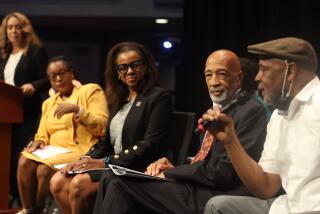Pay Gap Between Region’s Whites, Minorities Widens
- Share via
NORTHRIDGE — Countering a long-term national trend, members of most minority groups in Southern California earn less compared with whites than was true nearly 40 years ago, according to a new study.
The income gap widened most dramatically between Mexican Americans and non-Hispanic whites, the study shows.
U.S.-born Mexican American men were paid about 81% of the median income of non-Hispanic white men in 1959, but the figure dropped to 61% by 1989.
The trend was more apparent for Mexican American immigrants. Men born in Mexico saw their income fall from 66% in 1959 to 39% in 1989 of what white men were paid, while women born in Mexico experienced a parallel decline of from 81% to 52%, according to the study.
“This was the greatest surprise in our study,” said Eugene Turner, a geography professor at Cal State Northridge who wrote the study with fellow CSUN professor James P. Allen. “It contradicted many people’s belief that greater emphasis on civil rights and an expanded economy has lifted all boats.”
The wide-ranging study, called “The Ethnic Quilt: Population Diversity in Southern California,” covers 34 ethnic groups spread throughout Los Angeles, Orange, Ventura, Riverside and San Bernardino counties. It is based on decades of census and other data for the region, which in 1990 counted about 14.5 million residents.
The study also examined topics such as ethnic neighborhoods, jobs, education, home ownership, ethnic intermarriage and assimilation.
The study also showed that for black men, the income figures dropped from nearly 67% of what white men were earning in 1959, to nearly 57% in 1989. Similarly, black women saw their pay compared with white women drop from nearly 88% to about 78%.
Only Japanese American men improved their position, moving from about 85% of the median pay for non-Hispanic white men in 1959 to about 3% more than the median for whites in 1989.
To account for the widening income gaps, experts cited factors such as immigration of low-skilled, low-paid laborers; discrimination against minorities; and lower education levels among minorities.
And the study’s authors cautioned that the actual socioeconomic gap between some groups and non-Hispanic whites could be far more severe because of 1990 census undercounts.
Experts said that while gaps between the incomes of whites and minorities have varied, the 30 years covered by the study ultimately saw a general narrowing of income disparity nationally.
“The net effect over the entire period [1959-89] was still a narrowing of most gaps nationally,” according to the 282-page study.
Several activists and scholars agreed the growth of low-pay manufacturing and service jobs in Southern California had done much to keep overall pay down for minorities. And anti-minority sentiment displayed prominently by local movements against immigration and affirmative action help explain the inequities, they said.
“Our experience would tell us this is very true,” said Xavier Flores, executive director of Pueblo Y Salud, a San Fernando-based nonprofit social service agency. “I would tend to believe that immigration doesn’t answer it all. There’s also still a lot of discrimination, a lot of racism that keeps us from obtaining our employment goals.”
City Councilman Mark Ridley-Thomas, who represents parts of South Los Angeles, said the study’s findings must be tied to long-standing practices of separation based on race or class.
“It’s a significant factor, otherwise you would have a more equitable distribution,” Ridley-Thomas said. “There are adversaries who advocate effectively against programs that work toward the leveling of the playing field.”
Traditionally, intense immigration or education issues alone do not explain labor stratification, so factors such as discrimination are undeniable, said William Deverell, an associate professor of history at Caltech in Pasadena.
“It’s a dynamite snapshot of the diversity,” Deverell said of the study. “This offers a contemporary portrait of it.”
According to the study, at least part of the success of Japanese American men was due to the high incomes of Japanese-born executives based in Southern California.
The study included reviews of the disproportionate representation of ethnic groups in certain occupations.
In the five-county region, where more than half of all working men were white, nearly 90% of all male lawyers were white.
By comparison, the study found that nearly one-quarter of all working men were of Mexican descent, and about 7% were black, but for each group only about 3% were lawyers.
The top jobs for men of Mexican descent were sewing machine operator (68% of all men doing that job), groundskeeper (60%) and busboy (57%). Many black men were found to be bus drivers (33% of all men doing that job), postal clerks (28%) and guard/police officers (21%).
For women, about 55% of those working in the region were white.
Of all women working as actors or directors, 85% were white. Other common jobs for white women were postal clerk (25%) followed by janitor or cleaner (22%).
Top jobs for working women of Mexican descent were farm worker (78% of all women farm workers were of Mexican descent), sewing machine operator (57%) and assembler/laborer (52%).
Black women showed high representation in jobs such as postal clerk (40%), bus driver (36%) and guard/police (24%).
The study included groups such as American Indians, Belizean ancestry, Iranian ancestry, Laotians, Nigerian ancestry, Puerto Rican origin and Samoans.
Several scholars who reviewed the study said its most novel feature was the inclusion of groups, data and categories that normally go unnoticed.
For instance, the study concluded that marrying outside one’s own ethnic group was least common among Koreans, Cambodians and Vietnamese and most common among American Indians, Puerto Ricans and Cubans.
Edward Soja, a professor of urban and regional planning at UCLA, said the conclusions are presented without political bias. The results very likely can be used to bolster any number of views on ethnicity in Southern California and that is a plus, he said.
“It’s presenting, really, a tremendous resource that will feed all the debates,” Soja said. “You can become fascinated with one map.”
Leo Estrada, also a professor of urban planning at UCLA, said the study is an eye-opener even for those who are intimately familiar with the area. It detailed the ethnic mix of places such as the San Fernando Valley, he said.
“It does point to [ethnic] enclaves that are there,” Estrada said. “It may look white, especially in the far western part of it, but in reality this area is far from white.”
(BEGIN TEXT OF INFOBOX / INFOGRAPHIC)
Income Gap
The income gap between whites and minorities in Southern California continues to grow. Here’s a look at pay for minority men and women as a percentage of what white men and women made in the corresponding years.
Source: U.S. Bureau of the Census
More to Read
Sign up for Essential California
The most important California stories and recommendations in your inbox every morning.
You may occasionally receive promotional content from the Los Angeles Times.










